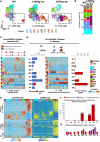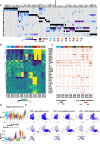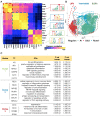Single-cell multimodal analysis identifies common regulatory programs in synovial fibroblasts of rheumatoid arthritis patients and modeled TNF-driven arthritis
- PMID: 35879783
- PMCID: PMC9316748
- DOI: 10.1186/s13073-022-01081-3
Single-cell multimodal analysis identifies common regulatory programs in synovial fibroblasts of rheumatoid arthritis patients and modeled TNF-driven arthritis
Abstract
Background: Synovial fibroblasts (SFs) are specialized cells of the synovium that provide nutrients and lubricants for the proper function of diarthrodial joints. Recent evidence appreciates the contribution of SF heterogeneity in arthritic pathologies. However, the normal SF profiles and the molecular networks that govern the transition from homeostatic to arthritic SF heterogeneity remain poorly defined.
Methods: We applied a combined analysis of single-cell (sc) transcriptomes and epigenomes (scRNA-seq and scATAC-seq) to SFs derived from naïve and hTNFtg mice (mice that overexpress human TNF, a murine model for rheumatoid arthritis), by employing the Seurat and ArchR packages. To identify the cellular differentiation lineages, we conducted velocity and trajectory analysis by combining state-of-the-art algorithms including scVelo, Slingshot, and PAGA. We integrated the transcriptomic and epigenomic data to infer gene regulatory networks using ArchR and custom-implemented algorithms. We performed a canonical correlation analysis-based integration of murine data with publicly available datasets from SFs of rheumatoid arthritis patients and sought to identify conserved gene regulatory networks by utilizing the SCENIC algorithm in the human arthritic scRNA-seq atlas.
Results: By comparing SFs from healthy and hTNFtg mice, we revealed seven homeostatic and two disease-specific subsets of SFs. In healthy synovium, SFs function towards chondro- and osteogenesis, tissue repair, and immune surveillance. The development of arthritis leads to shrinkage of homeostatic SFs and favors the emergence of SF profiles marked by Dkk3 and Lrrc15 expression, functioning towards enhanced inflammatory responses and matrix catabolic processes. Lineage inference analysis indicated that specific Thy1+ SFs at the root of trajectories lead to the intermediate Thy1+/Dkk3+/Lrrc15+ SF states and culminate in a destructive and inflammatory Thy1- SF identity. We further uncovered epigenetically primed gene programs driving the expansion of these arthritic SFs, regulated by NFkB and new candidates, such as Runx1. Cross-species analysis of human/mouse arthritic SF data determined conserved regulatory and transcriptional networks.
Conclusions: We revealed a dynamic SF landscape from health to arthritis providing a functional genomic blueprint to understand the joint pathophysiology and highlight the fibroblast-oriented therapeutic targets for combating chronic inflammatory and destructive arthritic disease.
© 2022. The Author(s).
Conflict of interest statement
The authors declare that they have no competing interests.
Figures








References
-
- Elliott M, Maini R, Feldmann M, Long-Fox A, Charles P, Katsikis P, et al. Treatment of rheumatoid arthritis with chimeric monoclonal antibodies to tumor necrosis factor alpha. Arthritis Rheum. 1993;36:1681–90. - PubMed
Publication types
MeSH terms
Substances
LinkOut - more resources
Full Text Sources
Medical
Miscellaneous

